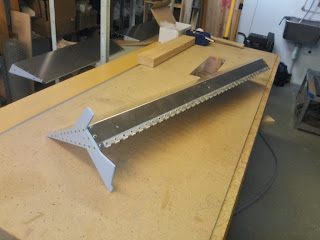Cut the openings in the ailerons, only deburring left. Also bought a new orange from
Hagmans. It was a bit more difficult to get a good finish, but the amount of pigment was abysmal also here. 4 coats of orange, and I still can easily see through it, it's ridiculous. Obviously I am doing something wrong here.
Looking a bit closer at Duplicolor web site what I have to do is first a plastic primer (also for fiber glass), then a white general purpose primer (white primer for bright colors), then the color itself (2-3 coats) and then a 2k transparent epoxy coat (2-3 layers) to achieve mechanical and chemical strength. This is not exactly straight forward and easy anymore, and with all those coats, it gets heavy. I begin to understand why people like Latex paint or real aviation products. The problem for me is that aviation paint products are practically speaking impossible to get. They can be sent from UK or USA, but the cost becomes ridiculous because they are labelled hazardous goods.
Anyway, I had a real eye opener this evening:
Polysiloxane coatings. Going for the
Jotun Yachting line of products, I only need one coat of Vinyl Yacht Primer (spray or brush) which I already have, and one coat of Topgloss BR, and it will last forever.
Topgloss BR is a new 2k polysiloxane coat especially made for brush and roller. It is supposed to be completely smooth and shiny, even when applied with brush and roller, which in fact is the preferable method. Polysiloxane is superior to urethane in all aspects as well as being non toxic, no isocyanates. Polysiloxane coats are completely resistant to UV and oxidation. Generally a coat of polysiloxane is more corrosion resistant, more weather resistant, higher chemical resistance, more temperature resistant, and more glossy than the usual 2 step epoxy primer and urethane top coat.
The "old" Jotun Yachting method was epoxy primer and urethane top coat. The new preferred method is 1k Vinyl primer and a top coat of 2k polysiloxane. The Vinyl primer is preferred because it is smoother (but also needed for wood). So I wonder, on an airplane it should generally be enough with only a coat of polysiloxane with no primer or anything. In fact what the vinyl primer does is only to make a smooth surface for the polysiloxane top coat when using brush and roller, but it could also be that Jotuns formulation of polysiloxane requires a primer for adhesion? I don't know, but my
guess is that using polysiloxane directly on aluminium would require 2 or 3 coats because it spreads so thin. And then it is faster and better to use the fast drying vinyl primer that is smooth and can be smoothed further by sanding. The spreading is incredible. 1 liter last for 30 square meters, film thickness of 30 micrometer. The older urethane top finish have the same film thicness, but only goes for 16 square meters due to higher VOC content.
I have read several places that people are using some
new paint system and using only brush and rollers,
Sprite Aviation for instances. This can only be polysiloxane coatings I guess.
So I ended up "Acetoning" all the orange paint off the tips. From now on there will be only polysiloxane coats on the Onex, with some Vinyl primer here and there (if needed). But this also means that I have to wait until I have more surfaces to cover because the paint is 2k. Another thing is that Jotun don't have orange, they only have a whole bunch of modern non-colors and "Draco Red". So Draco Red it is. Under the inner wing section and on the underside further back I will have some gray polysiloxane to protect the aluminium during the winter.






























